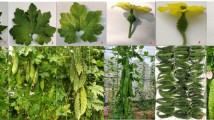Summary
The Giemsa banding patterns of four inbred lines (DB1113, DB1116, WIR44 and WIR27) ofZea mays and their hybrids have been compared. The polymorphism of knob heterochromatin of 4 chromosome pairs allowed to distinguish the 4 inbred lines on the basis of their banding patterns, reflected the evolutionary distance of the inbred lines and provided evidence as to the origin of these chromosomes in hybrids.
Sister chromatid differentiation by means of BrdUrd incorporation prior to fluorescence plus Giemsa(FPG)-technique revealed 3.7 SCEs per cell for the hybrid BEKOS 251. Individualization of chromosomes on the basis of their replication patterns or asymmetric bands after application of the same technique was impossible.
Zusammenfassung
Die Giemsabandenmuster der vier Inzuchtlinien des Maises DB1113, DB1116 (convar.vulgaris) und WIR27, WIR44 (convar.dentiformis) sowie der daraus entstandenen Hybriden SU 10, Kappa und BEKOS 251 wurden untereinander verglichen. Polymorphismen des Knob-Heterochromatins auf vier Chromosomenpaaren (I, VI, VII, VIII) erlaubten die Unterscheidung der vier Inzuchtlinien anhand ihrer Bandenmuster, widerspiegelten den jeweiligen Verwandtschaftsgrad zwischen den Inzuchtlinien und ermöglichten für einige Chromosomen der Hybriden den Herkunftsnachweis.
Schwesterchromatidendifferenzierung nach BrdUrd-Einbau und FPG-Färbung ergaben für die Doppelhybride BEKOS 251 3.7 SCEs/Zelle. Die Erfassung von Replikationsmustern oder asymmetrischen Banden zur Charakterisierung individueller Chromosomen war mit dieser Methode nicht möglich.
Краткое содержание
Сравнивают вид полос, окрашенных гимзой, четырёх инбридинг линий кукурузы DB1113, DB1116 (convar.vulgaris) и WIR27, WIR44 (convar.dentiformis), а также полученных от них гибридов SU 10, Kappa и BEKOS 251. Полиформизмы кноб-гетерохроматина на четырёх хромосомных парах (I, VI, VII, VIII) дают возможность различить четыре инбридинг линии по виду полос, стражающих состветствующюю степень родства между инбридинг линиями и облегчающиш определение происхождения для отдельных хромосом гибридов.
Дифференцирование сёстренских хроматид после инкорпорации BrdUrd и окраски с FPG дало для двойных гибридов BEKOS 251 3,7 обменов сёстринских хроматид в одной клетке. С помощью этого метода невозможно было показать репликационную картину или асимметрические полосы для характеристики индивидуальных хромосом.
Similar content being viewed by others
Literature
Aguiar-Perecin, M. L. R. de, andC. G. Vosa, 1985: C-banding in maize. II. Identification of somatic chromosomes. — Heredity54, 37–42.
Bennett, M. D., J. B. Smith, J. Ward, andG. Jenkins, 1981: The relationship between nuclear DNA content and centromere volume in higher plants. — J. Cell. Sci.47, 91–115.
andJ. S. Heslop-Harrison, 1982: Nuclear DNA amounts in angiosperms. — Proc. Roy. Soc. London Ser. B216, 179–199.
Bianchi, A., M. V. Chatnekar, andA. Ghidoni, 1963: Knobs in Italian maize. — Chromosoma14, 601–617.
Chou, T. S., andD. F. Weber, 1980: Effect of B-chromosomes on sister chromatid exchange in maize. — Genetics Suppl.94, 18.
Chow, C., andE. E. Larter, 1981: Centromeric banding in maize. — Can. J. Genet. Cytol.23, 255–258.
Döbel, P., I. Schubert, andR. Rieger, 1978: Distribution of heterochromatin in a reconstructed karyotype ofVicia faba as identified by banding and DNA-late replication patterns. — Chromosoma69, 193–209.
Gu Mingguang, Y. C. Ting, andZhang Xueqin, 1984: Studies on Giemsa C-banding in diploid perennial teosinte and its hybrids with maize. — Acta Genetica Sinica11, 276–280.
Gupta, D., andH. K. Jain, 1973: Genetic differentation of two Himalayan varieties of maize. — Ind. J. Genet. Plant Breed.33, 401–415.
Hadlaczky, G., andL. Kalman, 1975: Discrimination of homologous chromosomes of maize with Giemsa staining. — Heredity35, 371–374.
Longley, A. E., 1939: Knob position on corn chromosomes. — J. Agric. Res.59, 475–490.
Mastenbroek, I., andJ. M. J. de Wet, 1983: Chromosome C-banding ofZea mays and its closest relatives. — Can. J. Genet. Cytol.25, 203–209.
McClintock, B., 1929: Chromosome morphology inZea mays. — Science69, 629.
Molina, M. del C., 1981: Characterization of theZea mays chromosomes by the C-banding with Giemsa method. — Mendeliana5, 3–8.
, 1983: Cytogenetic studies onZea diploperennis. — The nucleus26, 1–7.
Nagl, W., 1976: Zellkern und Zellzyklen. Ulmer, Stuttgart.
Perry, P., andS. Wolff, 1974: New Giemsa-method for differential staining of sister chromatids. — Nature251, 156–158.
Pryor, A., K. Faulkner, M. M. Rhoades, andW. J. Peacook, 1980: Asynchronous replication of heterochromatin in maize. — Proc. Natl. Acad. Sci. USA77, 6705–6709.
Sachan, J. K. S., andR. Tanaka, 1976: A banding method forZea chromosomes. — Jap. J. Genet.51, 139–141.
, 1977: Variation and pattern of C-banding inZea chromosomes. — The nucleus20, 61–64.
Schubert, I., 1979: Differentielle Chromatidenmarkierung — ein Hilfsmittel für Untersuchungen zur Chromosomenstruktur, zum Zellzyklus und zur Entstehung von chromosomalen Strukturumbauten. — Biol. Zbl.98, 257–270.
, andR. Rieger, 1979: Asymetric banding ofVicia faba chromosomes after BrdUrdincorporation. — Chromosoma70, 385–391.
, andR. Rieger, 1979: Intrachromosomal distribution patterns of mutagen-induced sister chromatid exchanges and chromatid aberrations in reconstructed karyotypes ofVicia faba. — Mutation Res.59, 27–38.
Schubert, I., G. Künzel, H. Bretschneider, R. Rieger, andH. Nicoloff, 1980: Sister chromatid exchanges in barley. — Theor. Appl. Genet.56, 1–4.
Schvartzman, J. B., andF. Cortes, 1977: Sister chromatid exchanges inAllium cepa. — Chromosoma62, 119–131.
, andJ. F. Lopez-Saez, 1979: On the nature of sister chromatid exchanges in 5-bromodeoxyuridine-substituted chromosomes. — Genetics92, 1251–1264.
Song Yun-Chun, andLiu Li-Hua, 1983: Comparisons between the C-banding patterns of root tip chromosomes in different maize cultivars. — Acta Bot. Sin.25, 40–45.
Author information
Authors and Affiliations
Rights and permissions
About this article
Cite this article
Thi Khuong, N., Schubert, I. Differential staining of mitotic chromosomes from inbred lines and hybrids ofZea mays L.. Die Kulturpflanze 34, 195–205 (1986). https://doi.org/10.1007/BF02112801
Received:
Issue Date:
DOI: https://doi.org/10.1007/BF02112801




